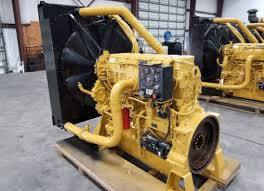There are three broad classification systems for engines. Engines are classified as two-cycle or four-cycle, depending on whether the combustion cycle is carried out in two or four piston strokes.
Also, engines are classified as spark-ignited (SI) if the air/fuel mixture is ignited by a spark or compression-ignited (CI) if ignition occurs by compression of the air/fuel mixture.
Due to its higher compression ratios and leaner combustion, a CI engine can deliver up to 40 percent better fuel economy than a similarly loaded SI engine. Finally, engines are classified as air or water cooled. Small, single-cylinder SI engines are air cooled, while large, multi-cylinder engines are water cooled.
Four-Stroke Engine in Agricultural Machinery
This type of engine completes one cycle in four strokes of the piston. Four events are associated with the travel of the piston for one cycle. There is a slight difference in operation between the spark ignition and compression ignition engines, as discussed below:
Spark Ignition (SI) Engine
This type of engine uses petrol, and the fuel-air mixture is carried out by a carburetor in the correct proportion. The carburetor also atomizes the mixture and sprays it into the cylinder for combustion. Below are the operations that take place in the cylinder to release the energy stored in the fuel:
1. Intake/Induction stroke: The piston moves from TDC to BDC, and the inlet valve is opened to allow the fuel-air mixture to enter and fill the partial vacuum created by the movement of the piston. The exhaust valve remains closed.
2. Compression stroke: The intake valve is closed, the exhaust valve remains closed, and the piston moves from BDC to TDC, compressing the fuel-air mixture into the clearance volume, raising its temperature.
3. Power stroke: When the piston approaches TDC during the compression stroke, a spark ignites the fuel mixture, and the expanding gases drive the piston from TDC to BDC.
4. Exhaust stroke: The piston returns from BDC to TDC, sweeping out burnt fuel through the exhaust valve, which has been opened, while the intake valve remains closed.
Read Also: Chiggers: Description, Damages Caused, Control and Preventive Measures
Compression Ignition (CI) Engine in Agricultural Machinery

This type of engine uses diesel fuel to achieve combustion in the cylinder. The diesel is atomized and injected into the cylinder by the aid of an injector. Below are the operations that take place in the cylinder to release the energy stored in the fuel:
1. Intake/Induction stroke: The piston moves from TDC to BDC, and only air is drawn into the cylinder. The inlet valve opens, while the exhaust valve remains closed.
2. Compression stroke: The air is compressed in the cylinder, raising its temperature very high. Both intake and exhaust valves are closed as the piston moves from BDC to TDC.
3. Power stroke: Just at the end of the compression stroke, a fine spray of diesel is injected into the hot compressed air, igniting the fuel instantly. The expanding gas drives the piston from TDC to BDC for the power stroke.
4. Exhaust stroke: The piston returns from BDC to TDC, sweeping out burnt fuel through the opened exhaust valve, while the intake valve remains closed.
Read Also: Scrapie in Sheep and Goats: Description, Damages Caused, Control and Preventive Measures
Two-Stroke Engine in Agricultural Machinery

This type of engine completes one cycle in only two strokes of the piston. There are no definite intake and exhaust valves, but instead, there are openings or ports located in the cylinder wall, which get covered or uncovered as the piston moves up and down the cylinder.
When the piston moves from TDC to BDC, a fresh fuel mixture enters through the intake port. At the same time, the burnt fuel escapes through the exhaust port, which is also uncovered.
The compression and power strokes are similar to those of the four-stroke engine. The piston makes only two strokes, which is one revolution of the crankshaft, to complete one cycle.
This article has outlined the internal combustion (IC) engines, the different types, and their working principles. The IC engines have two-stroke and four-stroke cycles of both the spark ignition and compression ignition engines, which are vital for various agricultural applications.
Do you have any questions, suggestions, or contributions? If so, please feel free to use the comment box below to share your thoughts. We also encourage you to kindly share this information with others who might benefit from it. Since we can’t reach everyone at once, we truly appreciate your help in spreading the word. Thank you so much for your support and for sharing!
Frequently Asked Questions
We will update this section soon.

